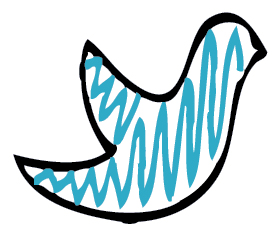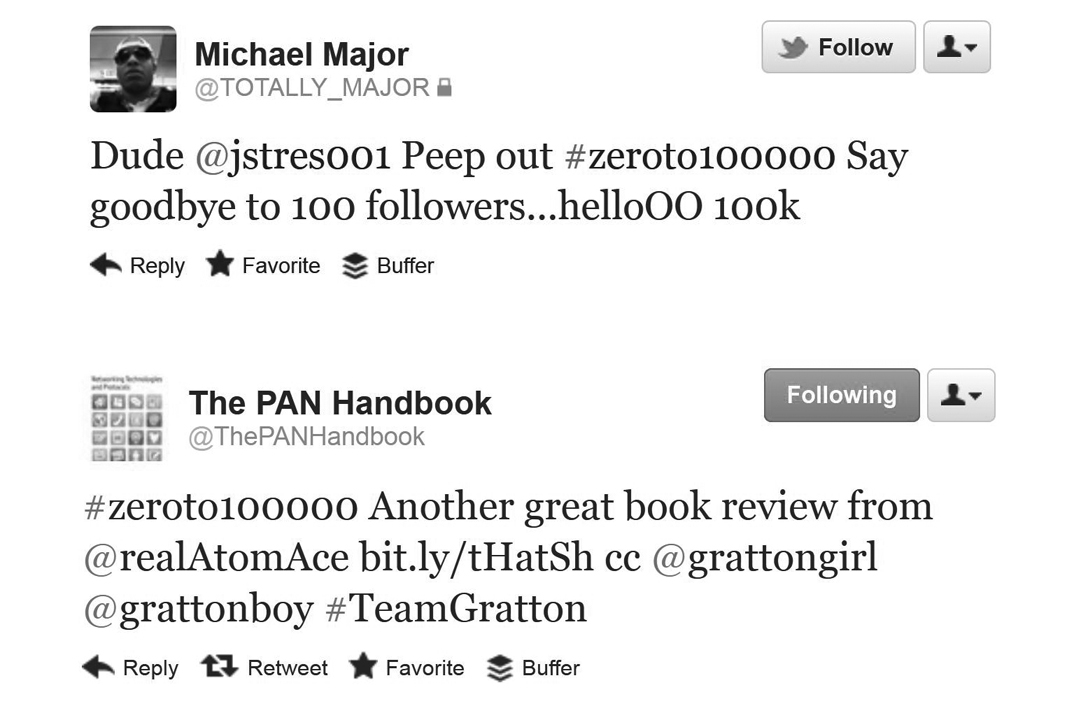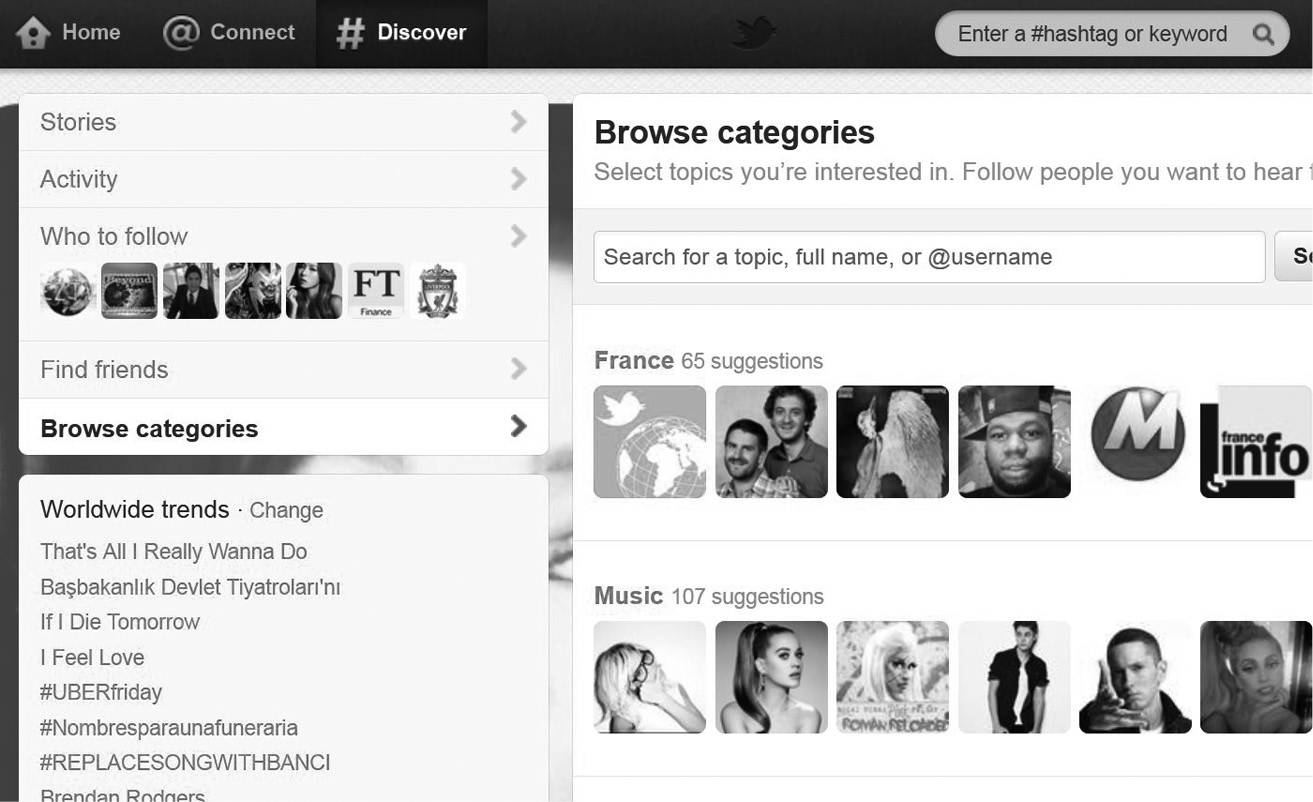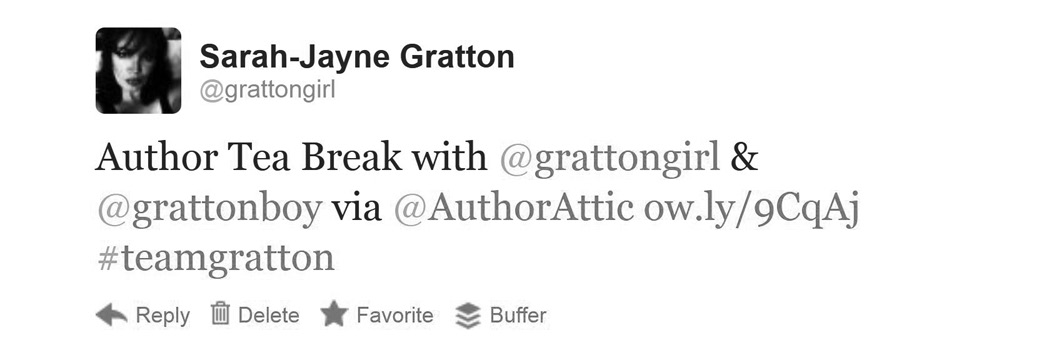Chapter 19
Twitter to the Power of Two
“Relationships and engagement are today’s new currency”
#TeamGratton

There’s something about Twitter that brings people together, and it’s not just on a personal branding level. I can personally vouch that it has also enriched my marriage.
Starting out on Twitter as @grattongirl was very much an experiment for me in social networking, one that I never anticipated would take me so far in such a short space of time. Within months of joining, I was well and truly hooked and found myself talking incessantly about the platform to my husband Dean who, at the time, wasn’t really into “the social networking thing,” as he called it back then.
But I guess my enthusiasm paid off. Eventually Dean decided to take a closer look at the platform I couldn’t get enough of. He initially signed up as @Dean_Gratton and promptly announced, “I don’t get it!”
“Just hang in there,” I told him with firm assurance, knowing that he was about to throw in the Twitter towel. He shrugged his shoulders in begrudging affirmation and asked me in an ambivalent tone, “So what do I do now?”
I explained to him what I had discovered myself: That Twitter wasn’t all about idle breakfast food chitchat, but was a powerful search tool and a great identifier of news and connections in my respective arenas. “Try out the search feature,” I prompted. “Use the words ‘Bluetooth,’ ‘wireless,’ or any other technology you’re planning to feature in your new book.”
A rise of his eyebrows told me he was a little more intrigued as he located the search feature on Twitter and began entering those all-important keywords. Several hours later he was still taking stock of everything he had managed to find and had to admit that Twitter had “blown him away.”
“I had no idea so many people I need to contact are on Twitter,” he remarked incredulously at dinner. “And the article links, the research papers — wow!”
And that was that! In a matter of hours, Dean was as hooked on Twitter as I. We chatted about its potential that night with all the excitement of a couple of children on Christmas Eve.
Going All the Way
And it got even better once Dean began tweeting himself. Like any virgin tweeter, he was slightly nervous to begin with, fumbling with his keyboard and rewording everything several times before clicking the Send button. But once he got the hang of it, there was no stopping him.
Again, Dean was blown away by the level of engagement he received. Always the geeky loner at school (Dean’s nickname was The Professor), he was suddenly Mr. Popular on Twitter — and what’s more, he loved it!
As the weeks went on, he began to show more and more of his personality through his tweets and to add humor and variety to the content
A Change of Handle
Then one day I received a tweet from a male admirer asking me, “Is there a @grattonboy in your life?” I laughed with Dean about it. “I’m your @grattonboy,” he exclaimed, and then he jumped up as though struck by lightning. “That’s it!” he yelled. “What?” I replied, slightly concerned by his outburst. “Don’t you see?” he said, taking my hand. “@grattonboy! That should be my Twitter handle.”
We talked about it some more and decided that it was still relatively early days for Dean on Twitter, so changing his handle shouldn’t be too much of a problem. We also acknowledged that @grattonboy was the obvious choice of name, considering my more-established Twitter persona as @grattongirl.
The next day, Dean informed his followers of his decision to change his handle to @grattonboy and his reason behind it. Suddenly the two of us were well and truly a Twitter couple and our united personal branding had begun (see Figure 19-1).
Figure 19-1
Dean’s changing his Twitter handle to @grattonboy fully united our personal brands.

Twitter’s Cutest Couple
Being a Twitter couple has been a rewarding personal branding exercise and very much a fun learning curve. To begin with, Dean and I would sneak in tweets referring to each other affectionately and sometimes recalling amusing stories about our life together. Over time, we became known as the cutest couple on Twitter (see Figure 19-2) and increasingly began to receive tweets addressing the two of us jointly, as well as individually.
As the number of our followers began increasing, we began to learn the tips and tricks of using Twitter in a way that allowed us to maximize our personal brand success on the platform. We were truly beginning to spread our Twitter wings and we weren’t afraid to try new things, including many of the Twitter tools that were being developed and that I cover in Chapters 20 through 23.
Figure 19-2
Our union on Twitter earned us the title “cutest couple.”

After several years on Twitter, I began to offer professional advice to new Twitter users and to help them create and promote their personal brand message. I was still very much involved in writing for the theater, and several of my screenplays had been optioned by major studios, but my fascination with using Twitter for personal branding became something of an obsession that led me to focus more and more on writing articles on the subject.
In 2010, our personal branding success on Twitter brought about an amazing opportunity. Dean and I were offered a contract to write a book about how to succeed in social media. The book was to be called Zero to 100,000. We used Twitter to publicize our progress, of course, and to discuss our intended chapters (along with venting our incessant need for caffeine) to our rapidly growing band of loyal followers.
As time progressed and the book grew near to completion, we tweeted promotional quotes using the hashtags #Zeroto100000 and #TeamGratton, along with links to the pre-order sites and the book’s own website.
Once launched, we invited readers to tweet their personal reviews of the book (see Figure 19-3), which they did in the thousands. It was a heady time for us both and one that proved to be a great marketing campaign for the book.
Figure 19-3
Using the hashtag #TeamGratton, we asked readers of our book to tweet their reviews.

From that point on, the hashtag #TeamGratton stuck and was soon being used outside the book’s promotional tweets. The hashtag identified us as both a couple and a brand that was becoming increasingly popular and powerful in the Twitter community.
One day, a promotions company asked us to review and endorse their products on Twitter. This began a steady stream of similar offers, some with a pay-check attached and all with the opportunity to receive a wide variety of products that were linked to the #TeamGratton group of interests. Together, we tested everything — wireless headphones, wine, and household appliances.
We must have done something right because the companies involved continue to use us to promote anything new they develop. This experience really drove home to us the effectiveness of using a loyal personal brand as a tool for recommendation and market progression.
These days, people buy into brand personality rather than a staid product description. It’s a powerful lesson, one that I relay to my clients again and again.
#TeamGratton’s Golden Rules for Personal Branding Success
This list touches on many of the things I covered in Chapters 3 through 10, as well as provides a few extra nuggets of information that will help you build your own personal branding success story.
1. Learn how to listen
The first step to personal branding success on Twitter is to listen to the conversation before getting involved. Think of starting out as going on a blind date.
You want to find out as much as you can about your partner before divulging too much about yourself, so take time to find out about those tweets and tweeters that are of interest and value to you through using Twitter’s #Discover pane options such as Stories, Find Friends, and Browse Categories (see Figure 19-4); it provides a range of topical content tailored to your bio.
Figure 19-4
Find and listen to what others are tweeting about using Twitter’s #Discover feature.

2. Spot and optimize trends in your brand sector
Look for those trends and themes that come up again and again in your sectors of interest. Use them to provide topics of discussion and value to your followers. Find new angles on articles you have read, comment on blog posts, and tweet about them. Share the topics that get you noticed as your enthusiasm will encourage others to join in the conversation.
3. Harmonize your personal brand voice
Think of your personal brand message as your social voice; a harmony of those facets of your personality that best reflect your brand message. Remember that your brand and your social voice are one and the same. Traditional media experts may have tried to separate them, but their dated philosophy fails to embrace the shift in communication that Twitter has been fundamental in bringing about.
It may take a little time to fine-tune your voice so, go easy on yourself and don’t rush things. For Dean and me, it was a matter of building our personal brand confidence through Twitter engagement and response, where little by little, our personalities began to shine through our tweets.
4. Use cross-platform promotion
I introduce cross-platform promotion (CPP) in Chapter 8 and mention it throughout the book many times, particularly in the other personal branding success stories in Part Three.
Remember that CPP involves spreading your message across all your social media platforms using Twitter as your primary platform for exposure. Include links in your tweets to your blog posts, website, Facebook, and Google+ accounts, and invite people to connect with you there, too (see Figure 19-5).
Acknowledge comments given on your blog through your tweets, and tweet thanks to those people sharing your brand content. Encourage the flow of information through connecting your cross-platform promotion links in Twitter chats and discussions. Be creative, and don’t forget to share other links of interest, too (see Figure 19-6).
Figure 19-5
I use cross-platform promotion (CPP) to encourage my followers to connect with me on my other social networks.

Figure 19-6
#TeamGratton creatively uses cross-platform promotion to promote interviews.

5. Create a Twittertorial calendar
As Chapter 7 explains, a Twittertorial calendar is an idea derived from a publication’s editorial calendar. It’s a means of organizing the content you have curated in easily scheduled posts that can be taken and formulated in your personal brand show on Twitter.
You Twittertorial calendar should embrace the four types of tweet introduced in Chapter 5: share, inform, thank, and engage (SITE). Blending them will over time become second nature to you, but in the early days pay careful attention to how you mix them throughout the day to gauge the optimum blend for your personal brand.
6. Beware the narcissists and trolls
Social media narcissism is very real and can be a negative influence on your personal brand if left unchecked. As you become more involved on Twitter, you’ll almost certainly encounter it, along with those Internet trolls who like nothing more than the opportunity to criticize others online (and most likely offline, too).
It will probably happen to you too: that moment of complete ego-driven mania, fueled by having achieved a certain number of followers. One minute you may be tweeting about the importance of sharing and the next you’re so seduced by all the responses and comments surrounding your wonderful Twitter show that you begin to feel like the new messiah! This is your red light, your signal to take a reality check and come back down to earth.
Social media narcissists are for the most part shallow and volatile. They take far more than they give out on their platforms, and it really isn’t worth investing your time on them. Participating in the world of the trolls and narcissists will only cause you setbacks on your road to personal branding success.
7. Schedule for success
As you know by now, I’m an advocate of scheduling your tweets, provided it’s done in the right way, using the right tools, and without losing that all important time for engagement with your followers. No matter how much you may want to avoid it, as your Twitter following grows, scheduling becomes more and more necessary to ensure that you have a global Twitter presence that works for your brand around the clock. Part Four takes you step by step with the best scheduling tools, enabling you to find the right ones for you.
8. Become a botinator
I introduce the concept of becoming a botinator in Chapter 6 and explain how in terms of quality and quantity of followers, it absolutely is possible to have it all!
Bots are definitely not quality followers, so keep your eyes open for them and remember the warning signs: A stream of junk or spam tweets indicates that these are most likely being sent from a bot. Also bear in mind that bots like to take different Twitter handles to repeatedly push the same content, so make a note of any tweets that look particularly suspicious and watch for recurrences.
Peruse the Twitter streams of any new followers to make sure they aren’t just blanket posting with no real purpose or interest in others. Paying attention will provide an immediate impression of their value.
9. Use hashtags and start a trending topic
Follow my tried-and-tested formula for creating a trending topic that I detail in Chapter 10. Study the topics that are currently trending and look for patterns that can link them to your hashtag. But don’t place unrelated hashtags in other trending topic tweets because doing so can get you in your follower’s bad graces. Instead, seek out content and links pertaining to what’s being tweeted about and use your hashtags to reinforce the message.
10. Have fun!
All our personal branding success stories have one constant underlying element: They are all based on enjoying Twitter and having fun while tweeting. Twitter should never be a chore. If it is, reassess how you’re using it and what’s hindering your enjoyment.
#TeamGratton’s Favorite Twitter Tools
Normally, I’d write about the Twitter tools that have made a difference to my personal brand and contributed to it becoming a success. But instead of adding just a few personal paragraphs, I’ve decided to feature a whole section of the book on the subject: Part Four.
There are so many wonderful tools out there, and choosing the right ones will dramatically enhance your personal branding endeavors, saving you time and making your Twitter experience a far more pleasurable one.
So, turn the page and start exploring all the options in Chapters 20 through 23. You’ll find it an immensely valuable guide that will enable you to create your own Twitter toolkit.

